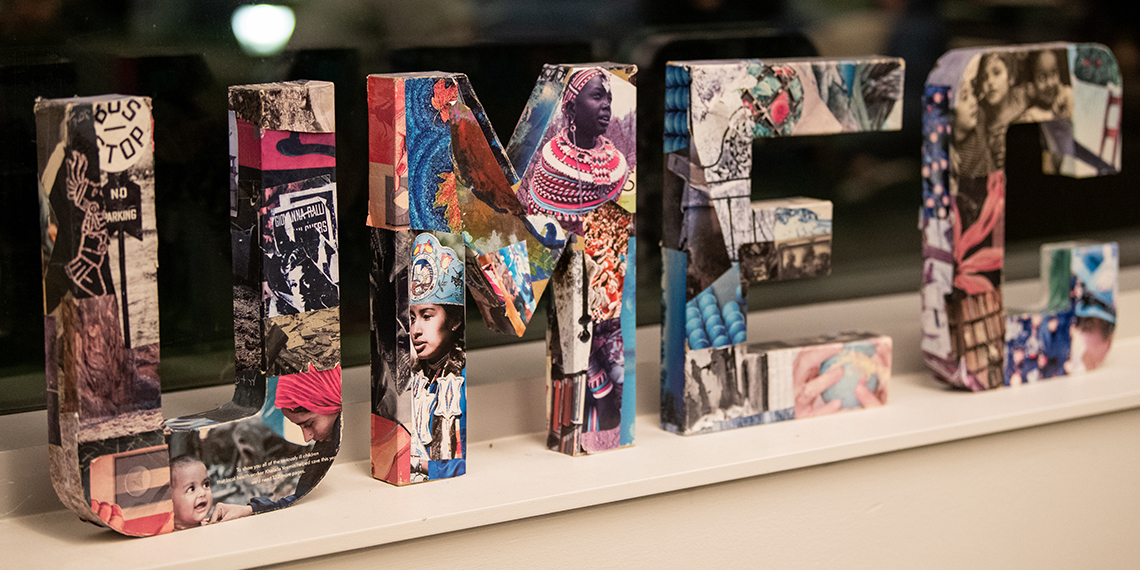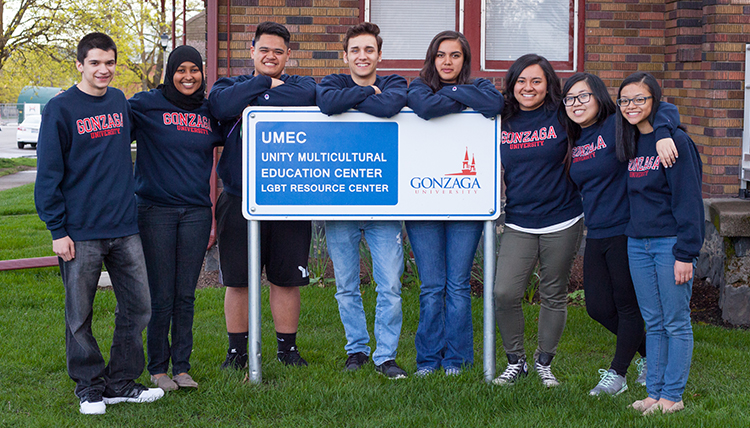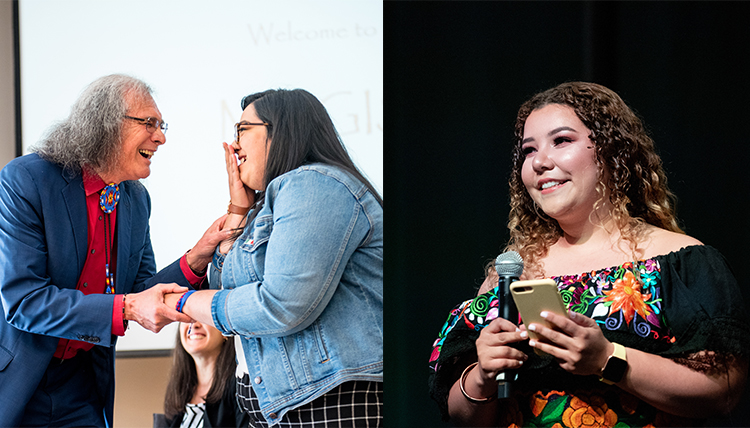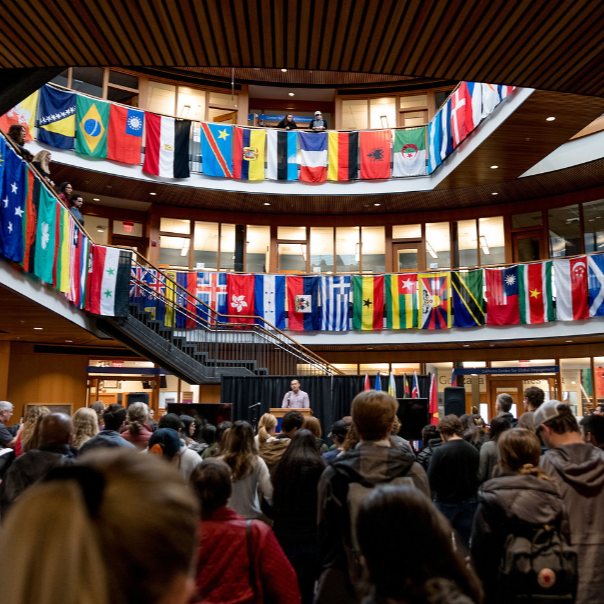The Building of Belonging: Celebrating UMEC's 25th Anniversary

A brick home on Gonzaga’s campus, Unity House emerged as a refuge, a safe harbor for diverse perspectives and experiences. It also birthed a powerhouse of student activism and potential that became the apex of hope for unity in the campus community.
Now called the Unity Multicultural Education Center (UMEC), the Unity House was born from strife, formed from the urgency felt by students of color at a predominantly white institution. They faced back-to-back-to-back racial threats at GU in 1995, ’96 and ’97, prompting Father Bernard Coughlin, S.J., then president, to assign several members of campus to develop an action plan. Related decisions led to establishing the Gonzaga Institute for Hate Studies (now the Center for the Study of Hate), a commitment to diversifying the workforce (still underway) and creating a space to gather for students most impacted by biases.
The catalyst was Bob Bartlett, an assistant dean of Student Affairs.
“Bob was advocating for this before any critical incident occurred, before it became fashionable to talk about inclusion and belonging. He gave it his heart and soul,” recalls Raymond Reyes, who supported Bartlett in developing greater resources for students of color and others who were commonly targets of exclusion.
For both of them – an African American and a Mexican- Native American – the work was “like salmon swimming upstream,” Reyes says. They collected all the synergy they could to “make a difference with difference,” as Reyes puts it. “It was the place students could go and unpack their experiences of racism before we had a bias team to address concerns formally.”

Early on, participation at Unity House was a small percentage of the greater diverse population at Gonzaga. But when Bartlett, Reyes and colleague Ana Gonzalez started the BRIDGE program (2005) to offer a specialized pre-orientation for students identifying as Black, Indigenous or People of Color (BIPOC), participation at Unity House blossomed.
So did the conversations. Students came to the house to share the implicit biases they experienced in classrooms and other settings, but also simply to hang out and talk about history and literature and other classes, and unpack what professors had presented.
UMEC, says Reyes, was not a place for students to run away from racism. “No. It was a place to decenter whiteness (before we even knew that phrase), and to reimagine what education could be.”
DEVELOPING A CULTURALLY INFORMED CAMPUS
What the students were asking for, Bartlett and Reyes found, was culturally informed education. And that realization fueled many other projects that would impact virtually every aspect of the university.
In a short time, there would be the first chief diversity officer position and a diversity requirement added to the core curriculum in the College of Arts and Sciences (both in 1998). Soon came bias training through the Intercultural Development Inventory in 2004 and the LGBTQ+ Center in 2005, alongside the BRIDGE program. In 2007, Gonzaga completed its first campus climate assessment to understand how well faculty, staff and students felt supported, and the next year, a mentorship program launched.
“It was a watershed period, those first 10-15 years of UMEC,” Reyes says.
After Bartlett’s departure, there was a vacuum in leadership and a period of frequent change. Then, action picked up and continues strong today. Joan Iva Fawcett oversees the Diversity, Equity and Inclusion pillar of Student Affairs, and last summer added two new directors – UMEC’s Jessie Mancilla and the Lincoln LGBTQ+ Resource Center’s Jamie Bartlett (no relation to Bob).
Gonzaga has admitted more diverse classes of students and hired more people of color to carry out the academic and spiritual mission of the University. There is more to do, but the addition of leaders to diversity-related programming is a solid indicator of progress.

SPEAKING FROM EXPERIENCE
“I can’t imagine my experience at Gonzaga without thinking about UMEC,” says Rani Chavez (they/them), a 2018 grad who eventually oversaw the BRIDGE orientation program that they had benefited from personally.
“When I think about my experience overall, so much of it is rooted in that first week when I was a BRIDGE student,” Chavez says. “I was introduced to all these topics that weren’t really discussed in my high school.”
They continue: “One thing my high school didn’t necessarily prepare me for was the transition to being underrepresented at a predominantly white institution. I think the support system through BRIDGE was so foundational to making Gonzaga feel like a home.”
Liz Perez (’20) also recalls BRIDGE as a first-year student, and the ensuing culture shock during the main orientation where the diversity of the student body was low. “It was a little bit of an adjustment period, so I really relied on UMEC,” Perez says. “I knew that I could talk to one of the mentors or staff and faculty and they would understand me in a way that maybe some of my other professors or friends wouldn’t.”
“UMEC really did shape my experience and became a second home,” Perez says. “It was a safe space. It was somewhere I knew I could have fun or even challenge my thinking and other leadership skills and develop those abilities, with the comfort of knowing that my boss is going to assist me where I need growth.”
Perez loves what she’s seeing UMEC offer for students now: a homier atmosphere with better access on the second floor of Hemmingson Center, the catching up at monthly Soup for the Soul gatherings and the annual Diversity Monologues, a student-run storytelling showcase.
A ROADMAP FOR INCLUSIVITY
This spring, under the direction of Robin Kelley, chief diversity officer, Gonzaga will roll out an Inclusive Excellence Strategic Plan, a roadmap to help Gonzaga achieve aspirations to be more inclusive and equitable. Kelley’s vision today with the Office of Inclusive Excellence is the actualization of what her predecessor, Reyes, dreamed decades ago, including a strong focus on these priorities:
- Recruitment, retention and success
- Campus climate and intergroup relationships
- Teaching, scholarship and service
- Education, training and development
- Community relations and partnerships
- Assessment, reporting and accountability
Objectives include increasing the representation of culturally diverse populations among all components of the campus, from students to faculty and staff to administrative leadership. Also important is reducing the incidence of bias complaints, offering incentives to faculty and staff to pursue related training, and promoting engagement in multicultural activities by all campus communities.
“We want to embody our educational mission authentically in an increasingly culturally diverse context,” Kelley says. “In keeping with our Catholic, Jesuit and humanistic identity, we aim to foster the development of our students, preparing them for social justice-driven citizenship and leadership.”
A PLACE OF BELONGING
While the phrase “diversity, equity and inclusion” or “DEI” has become commonplace over the past several years, Kelley has added “belonging” and “justice” to the thread to encompass the fullness of what diversity work seeks to accomplish.
“We want to create a sustainable, inclusive community where all members are welcomed, valued and supported and have a sense of belonging,” Kelley says.
Mancilla, UMEC’s new director, says that sense of belonging for historically marginalized populations is the heart of his work with students. He hopes to foster a stronger connection between UMEC programming and the related work occurring through Mission and Ministry, the Lincoln Center and other campus programs such as Gonzaga Outdoors.
That, he says, will help create a stronger community.
“Making students feel at home here at GU is the focus I’m wanting,” Mancilla says.
Beyond student life activities, he also aims to bolster the support to set up students for success in academics and career pursuits. He envisions study groups for the GRE, MCAT and LSAT exams, for example, and strong connections with the Alumni of Color affinity group to encourage mentorship opportunities.
“It’s a holistic approach,” he adds.
HOPEFUL FUTURE
The work at a predominantly white institution is only successful if it becomes a place of unity – “a learning and generative space where faculty and students collaboratively pursue knowing the similarities and understanding the differences,” Reyes says.
He continues, “The power of UMEC is inclusive belonging where difference is the center of gravity for building a beloved multicultural community. My hope for the next 25 years is for the teaching and learning in the classroom to build upon what began at Unity House as antiracist and inclusive exploration."
LEARN MORE
- Understand more about Diversity, Equity, Inclusion, Belonging and Justice at Gonzaga through the Office of Inclusive Excellence.
Celebrate UMEC’s Anniversary with a Gift!
A $5,000 crowdfunding project aims to support the Unity Multicultural Education Center’s advocacy for underrepresented students and provide experiential learning opportunities for all Zags to create a community that integrates and values multiple perspectives and cultural narratives.
- Help meet or exceed the $5,000 goal! Give online here.
population here at Gonzaga.” —Aaliyah L. ’23
- Diversity & Inclusion
- Student Life
- Alumni
- Gonzaga Magazine




